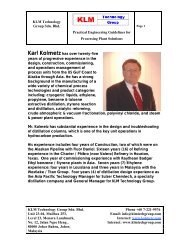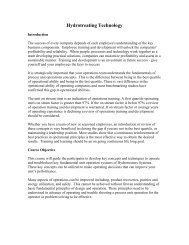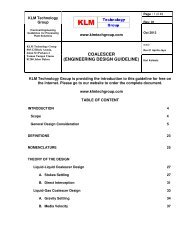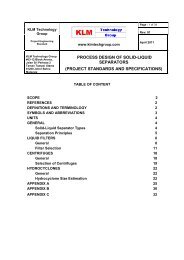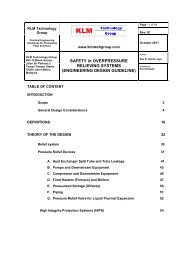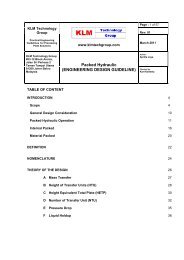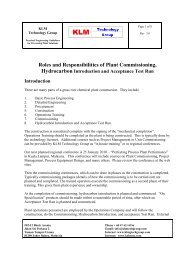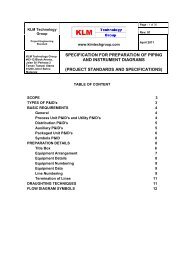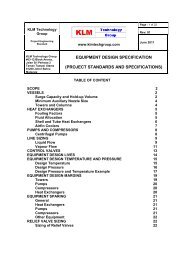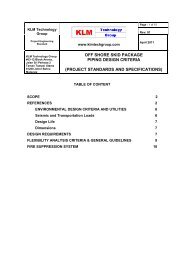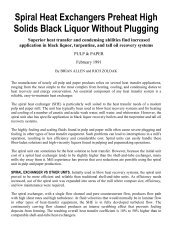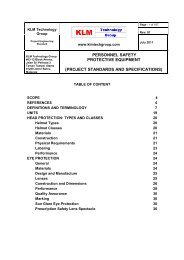air separation units (engineering design guideline) - KLM ...
air separation units (engineering design guideline) - KLM ...
air separation units (engineering design guideline) - KLM ...
You also want an ePaper? Increase the reach of your titles
YUMPU automatically turns print PDFs into web optimized ePapers that Google loves.
<strong>KLM</strong> TechnologyGroupPractical EngineeringGuidelines for Processing PlantSolutionsAIR SEPARATION UNITS(ENGINEERING DESIGN GUIDELINES)Page 15 of 69Rev: 01Jan 2013To achieve the low distillation temperatures an Air Separation Unit (ASU) requires arefrigeration cycle that operates by means of the Joule–Thomson effect, and the coldequipment has to be kept within an insulated enclosure (commonly called a "cold box").The cooling of the gases requires a large amount of energy to make this refrigerationcycle work and is delivered by an <strong>air</strong> compressor. The process consists of the followingmain steps.Before compression the <strong>air</strong> is pre-filtered of dust. Air is compressed where the finaldelivery pressure is determined by recoveries and the fluid state (gas or liquid) of theproducts. Typical pressures range between 5 and 10 bar gauge. The <strong>air</strong> stream mayalso be compressed to different pressures to enhance the efficiency of the ASU. Duringcompression water is condensed out in inter-stage coolers.The process <strong>air</strong> is generally passed through a molecular sieve bed, which removes anyremaining water vapor, as well as carbon dioxide, which would freeze and plug thecryogenic equipment. Molecular sieves are often <strong>design</strong>ed to remove any gaseoushydrocarbons from the <strong>air</strong>, since these can be a problem in the subsequent <strong>air</strong>distillation that could lead to explosions. The molecular sieves bed must beregenerated. This is done by installing multiple <strong>units</strong> operating in alternating mode andusing the dry co-produced waste gas to desorbs the water.Process <strong>air</strong> is passed through an integrated heat exchanger (usually a plate fin heatexchanger) and cooled against product (and waste) cryogenic streams. Part of the <strong>air</strong>liquefies to form a liquid that is enriched in oxygen. The remaining gas is richer innitrogen and is distilled to almost pure nitrogen (typically < 1ppm) in a high pressure(HP) distillation column. The condenser of this column requires refrigeration which isobtained from expanding the more oxygen rich stream further across a valve or throughan Expander, (a reverse compressor).Alternatively the condenser may be cooled by interchanging heat with a reboiler in a lowpressure (LP) distillation column (operating at 1.2-1.3 bar abs.) when the ASU isproducing pure oxygen. To minimize the compression cost the combinedcondenser/reboiler of the HP/LP columns must operate with a temperature difference ofonly 1-2 degrees Kelvin, requiring plate fin brazed aluminum heat exchangers. Typicaloxygen purities range in from 97.5% to 99.5% and influence the maximum recovery ofoxygen. The refrigeration required for producing liquid products is obtained using the JTeffect in an expander which feeds compressed <strong>air</strong> directly to the low pressure column.Hence, a certain part of the <strong>air</strong> is not to be separated and must leave the low pressurecolumn as a waste stream from its upper section.These <strong>design</strong> <strong>guideline</strong> are believed to be as accurate as possible, but are very general and not for specific <strong>design</strong>cases. They were <strong>design</strong>ed for engineers to do preliminary <strong>design</strong>s and process specification sheets. The final<strong>design</strong> must always be guaranteed for the service selected by the manufacturing vendor, but these <strong>guideline</strong>s willgreatly reduce the amount of up front <strong>engineering</strong> hours that are required to develop the final <strong>design</strong>. The <strong>guideline</strong>sare a training tool for young engineers or a resource for engineers with experience.This document is entrusted to the recipient personally, but the copyright remains with us. It must not be copied,reproduced or in any way communicated or made accessible to third parties without our written consent.



